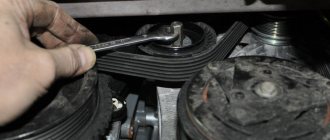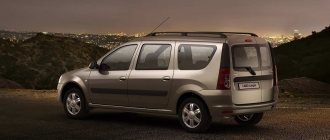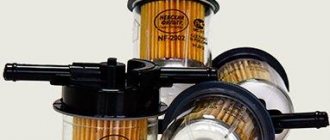Wild Savings
Compressed gas is made from natural gas, and its main component is methane. The same one that is burned in houses with gas stoves. And its advantages are immediately obvious: methane combustion products are relatively safe, and its price is significantly lower than that of gasoline and propane-butane (liquefied gas). The latter, by the way, is quite popular among motorists.
Gas equipment (GBO)
for methane with installation it costs about 90 thousand rubles. This is 2-3 times more expensive than gas equipment for propane-butane, because methane is stored under a pressure of about 200 atmospheres, which requires much more durable cylinders and affects other elements of the system.
But methane is cheap: average prices fluctuate in the range of 15-17 rubles per cubic meter. The cost of gasoline is 45 rubles per liter.
According to Autoreview tests, methane consumption for Lada Vesta CNG ranges from 7.8 cubic meters per 100 km on the highway to 12 cubic meters per 100 km in the city. The magazine "Behind the Wheel" gives slightly more optimistic values - the average consumption is about 6.2 cubic meters per 100 km.
Taking into account the significant difference in price, methane allows you to save about 2 rubles per kilometer. Profit? And another thing: let’s say, an average annual mileage of 20 thousand kilometers allows you to save up to 40 thousand rubles per year.
And even taking into account the high cost of methane gas equipment, its payback period for the specified mileage is about two years. But this is if you drive exclusively on methane.
CNG filling station 2020 – Gas car | Gazelle on methane
Gazelle on methane
Natural gas is used for the conversion mainly of commercial vehicles of the Gazelle class (up to 80% of the entire methane vehicle fleet), as well as large enterprises with their own CNG filling stations.
Savings on fuel for a car can be very significant, which is especially attractive for commercial and public vehicles that have significant annual mileage. The use of CNG as fuel for cars allows reducing fuel costs by 50%, thereby increasing the profit of a transport enterprise.
There are statistics on the performance indicators of the GAZ-3302-14 car when running on gasoline and methane (under normal condition of the car and average operating conditions):
| Indicators | Petrol | Methane |
| Average monthly mileage | 5000 | 5000 |
| Average fuel consumption, 1 l (m3)/100 km | 16 | 18 |
| Fuel tank/cylinder volume, l (m3) | 60 | 60 |
| Mileage at one gas station, km | 375 | 333 |
| Price of 1 liter (m3) of fuel, rub. | 16 | 7 |
| Monthly fuel consumption, l (m3) | 800 | 900 |
Thus, provided that the average monthly mileage is 5,000 kilometers and the average cost of installing LPG (for example, the 3rd generation with a lambda control system), the payback period due to the difference in the price of methane and gasoline will be approximately 7 months.
What gas equipment is usually installed on the Gazelle? It all depends on what year it was manufactured and, accordingly, what type of fuel injection (carburetor or injection) it uses. If until the end of 2006, Gazelles were produced in both modifications, then since 2007, the Gorky Automobile Plant has been producing mainly injection modifications of Gazelles.
At the moment, three types of generation of gas systems can be distinguished according to the principle of their operation:
- Second generation, or “gas carburetor”. Mechanical systems with vacuum, but more often electronically controlled, which are installed on gasoline carburetor cars.
— Third generation, or “gas carburetor with lambda control system.” Mechanical systems supplemented by an electronic dosing device operating on the principle of feedback from an oxygen sensor (lambda probe). They are installed on cars equipped with an injection engine, a lambda probe and a catalytic converter.
— Fourth generation, or “gas injector”. Distributed sequential gas injection systems with electromagnetic injectors, which are controlled by a more advanced electronic unit.
The main difference between the second and third generation systems is that in them gas from the gearbox enters a mixer installed between the air filter and the throttle valve (for carburetor cars, gas fittings can be directly inserted into the carburetor). And the difference between them is in the methods of regulating the gas supply. In the first system, the gas flow into the mixer is controlled mechanically. This is done using a dispenser, which is a tap that changes the flow area when turned. The second uses an electronic dispenser that regulates the gas supply and is controlled by an electronic unit. The ECU receives information from the lambda probe, throttle position sensor and engine speed sensor, using it to generate a control signal to the stepper motor, which constantly changes the gas supply adjustment through the dispenser.
These systems also differ in the method of tuning engine operation. In the “gas carburetor” system, the average position of the dispenser is set, at which the engine operates normally (double-adjustable dispensers can regulate the gas differently for the primary and secondary chambers of the carburetor). This position is determined using a gas analyzer. The position of the dispenser remains constant while driving, and the gearbox is responsible for the final adjustment of the mixture. The lambda control system is configured using a computer. While driving in various modes, the settings of the dispenser control unit change. The main difference is that while the engine is running, the dispenser operates and, depending on the ECU signals, changes the gas supply settings.
The “gas injector” has a completely different operating principle. In this system there is no mixer, and gas is supplied through gas injectors, which operate similarly to gasoline injectors. Signals to activate the injectors (determining the amount of injected gas) come from the electronic gas control unit. At the same time, to operate on gas fuel, the gas control unit recalculates the parameters coming from the standard ECU. The big advantage of this generation is that the ECU automatically switches the car to gas consumption mode after reaching the required engine temperature. The tuning process is performed using diagnostic equipment.
Injection gas equipment is a more high-tech equipment and produces maximum effect when used on a good engine that is maintained under normal conditions, which not all Gazelles can boast of. Considering its cost, which is much higher, operating such equipment at less than full capacity means high costs and a significant increase in payback periods.
An interesting direction in the development of these technologies in the foreseeable future is the installation of catalytic equipment on Gazelle for producing hydrogen-containing synthesis gas from natural gas. Using a mixture of CNG with synthesis gas additives, the cost per 100 km of travel in fuel prices when switching from gasoline to CNG with synthesis gas additives is 3.83 times (and when switching simply to CNG they are reduced by 3.28 times). Read more about the experimental Gazelle using synthesis gas here.
There are several forums on the Internet dedicated to the conversion and operation of commercial vehicles to methane. For example, very interesting comments and reviews can be found on the “Gazelle Club” forum.
Why is it difficult to drive on methane?
Refueling with methane is provided not by the gas stations we are used to, but by the so-called CNG filling stations - compressor stations.
500 such stations
have remained in Russia and in recent years their total number has not increased - now, according to estimates, there are only 360. In each region there is an average of
15-20 CNG filling stations, and they make up only 2%
of the total number of gas stations .
The rarity of CNG filling stations complicates the use of a methane car, especially since the mileage on a full charge of methane is usually low. For example, the first production passenger car with LPG - Lada Vesta CNG - has a 90-liter cylinder,
into which you can fill approximately 18−20 cubic meters of methane (the value is indicated at atmospheric pressure).
With this amount, the car travels 250-300 kilometers
. The distance between some CNG filling stations is greater than this value, so when using methane gas filling stations, part of the mileage will still take place in gasoline mode. And this increases the payback time of the equipment.
Why is it worth converting your car to methane?
text: 5th wheel / 01/02/2014
Today, methane occupies a central place in the debate about alternative types of automobile fuel.
It is called the main competitor of gasoline and diesel. Methane has already gained great popularity in the world: public transport and special equipment in the USA, China, Italy and many other countries are fueled exclusively with this environmentally friendly fuel. This year, the trend of switching to methane was also supported by Russia, a country that has the largest reserves of “blue fuel” in the world.
We recommend reading: In what cases can a bank impose a penalty on an individual and how much?
Don't confuse the gas Methane is the main component of natural gas, which is used as a fuel in compressed form.
Most often, methane is confused with propane-butane, liquefied petroleum gas, which is also used as automobile fuel.
However, these are two completely different products!
If the propane-butane mixture is produced at oil refineries, then methane is, in fact, a finished fuel that goes straight from the field to gas stations. Before filling the car tank, methane is compressed in a compressor. Therefore, the composition of methane is always the same, it cannot be diluted or spoiled.
Why methane? Methane is not called the most promising fuel for nothing.
And, perhaps, primarily because of its attractive price. Refueling a car is 2-3 times cheaper than gasoline or diesel. The low cost of methane is partly due to the fact that it is the only fuel in Russia whose cost is legally regulated.
But it's clean
Methane is a light hydrocarbon consisting of one carbon atom and four hydrogen atoms. It contains virtually no harmful impurities and heavy hydrocarbons, which lead to the formation of soot and tar in the engine.
The exhaust of methane cars is also cleaner, although it still contains nitrogen oxides, which are formed due to the high temperature in the combustion chamber and the presence of oxygen in it. But the content of soot, unburned hydrocarbons and carbon monoxide is significantly lower than in the case of gasoline and diesel engines.
In addition, methane has a high octane number (up to 110 units), so if you create an engine to run primarily on methane, you can increase the compression ratio.
The transition of transport to gas engine fuel is being promoted under the banner of the fight for the environment. Last year, during a direct line, President Vladimir Putin even drew parallels between methane cars and electric cars: in his opinion, the first path is more promising for Russia.
Difficulties of legalization
True, installation of HBO on a car requires registration of changes
, and in Russia the procedure is bureaucratic to the point of absurdity. The saddest thing is not even the high cost and tediousness. The main thing is that the procedure is almost useless, because the checks are formal in nature and do not guarantee the safety of the equipment for the owner (except on paper). However, a few years ago, a campaign began to catch cars with illegal gas equipment.
Starting in July, we will face another tightening of the screws, and if now communication with accredited laboratories is possible remotely, the new GOST 33670 requires a visit to such a center. And there are only 15 of them in Russia.
In a sense, the government’s policy is contradictory: on the one hand, people are encouraged to switch to HBO, on the other, they create obstacles. Concern for the safety of equipment operating under enormous pressure is understandable, but given the formality of the procedure, it is unlikely to evoke understanding among car owners.
For reference
Compressed natural gas (CNG, compressed natural gas) is used as a motor fuel. Gas is produced by compressing natural gas in compressor units. Storage and transportation of compressed natural gas takes place in special gas storage tanks under a pressure of 200–220 bar. Biogas is also added to compressed natural gas, which reduces carbon emissions into the atmosphere. The main component of natural gas is methane; it is lighter than air and, in the event of an emergency spill, quickly evaporates, unlike heavier propane, which accumulates in natural and artificial depressions and creates the risk of explosion. CNG is non-toxic in small concentrations, does not cause corrosion of metals, is superior in calorific value to any petroleum fuel; when burned, it does not leave soot, and the exhaust gases do not have sulfur impurities and do not destroy metal. Low boiling point is the key to complete evaporation of natural gas at low ambient temperatures. Compressed natural gas methane is the cheapest type of motor fuel currently in common use. Fuel costs per 100 km driven on a car with a CNG engine are almost 60% lower than on cars with liquefied petroleum gas (LPG) engines.
GAZelle-Business: methane field
Are there any ready-made solutions?
Lada Vesta CNG
became the first passenger car with a serial
gas equipment
for working on methane, the second in line is Largus CNG, the production of which started in February.
The factory version does not require separate legalization of LPG; in addition, both cars retained the gas tank, and the mileage on a full fill exceeds 1000 km.
But the same Vesta CNG
170 thousand rubles more expensive than a similarly equipped petrol Vesta, although 115 thousand rubles can be compensated under the EcoGas program.
In addition, in a number of regions there are subsidies for the purchase of methane cars, for example, customers are provided with fuel cards that provide 50 percent savings on the first 1,500 cubic meters of gas.
One of the problems with methane machines is the volume that the cylinder takes up. Vesta's trunk, for example, is reduced from 480 to 360 liters. For the Largus van, the same 90-liter cylinder reduces the volume even further - by 315 liters.
However, the development of the ANGCS network could stimulate engineering thought. For example, in Europe, cars are in demand in which the main fuel is methane, and the cylinders are located under the floor, without taking up the volume of the trunk. In Russia, the rarity of methane CNG filling stations makes such a solution impossible: gasoline still remains the main type of fuel.
GAZ-330262–240
Buy Gazelle-Business board
GAZ-330262–240
Cargo base 4.1 m, three-seater cabin, rear-wheel drive, gasoline-methane, awning.
from 1,276,000 ₽
Send a request
call me back
- Photos
- Peculiarities
- Equipment
- Characteristics
- Dimensions
- Service
Flatbed car
Single row cab
Number of seats 1+2
Extended base
Rear drive
HBO methane
GAZ-330252–750 - Gazelle-Business with EvoTech 2.l methane-gasoline engine. Triple cabin. Rear drive. The length of the loading platform is 4.1 m.
Peculiarities
Bi-fuel engine The UMZ-4216 gasoline engine is adapted for methane on Gazelles. The model has been familiar to consumers since the launch of the Business line in 2010. Today's UMZ-4216 has acquired an electronic gas pedal, a throttle device and Delphi injectors. There are hydraulic compensators on the valves, and the engine sealing elements have been replaced. When running on gasoline, the UMZ-4216 spends an average of 15 liters per 100 km, and on methane - 10.5 m3 per 100 km. The mileage on one gas tank is 400 km. Let's add LPG here, and the range between refuelings will increase to 700 km. If the owner of a Gazelle drives only on methane, he saves 60 rubles out of 100.
For fans of Trans-Volga engines, we offer the GAZ-330262–240 with the ZMZ-409 engine.
Extended body You can save money not only on fuel. If an entrepreneur works with light loads, a Gazelle with a body increased to 4.1 m will make two flights instead of three. With a body extended to 5.1 m - one flight instead of two. To transport long items, order a super-extended platform of 6.6 m. Each type of extension is equipped with an awning in size.
Three-seater cabin The Gazelle's workspace includes an adjustable driver's seat, a double passenger sofa and a new stove and dashboard. Now the cabin has niches for gadgets and a cup holder, space for a multimedia center and a tachograph. The instrument cluster was taken from Gazelle-Next.
Rear-wheel drive The rear-wheel drive layout gives the Gazelle an advantage over its competitors. GAZ-330262 with a reinforced rear axle is stable on slippery roads. A loaded body presses the drive wheels tightly to the ground and improves traction. The same principle works when the car gets into a hole: the rear-wheel drive Gazelle is designed taking into account the road conditions of Russia. The front wheels without drive give a greater turning angle than the drive wheels of foreign cars.
Methane gas treatment increases the price of the Gazelle by 16%. This figure is compensated by the modest costs of maintaining the GAZ-330262–240. For 2020, the average cost of a liter of methane is 11 rubles. The extended body reduces the number of flights. The combination of these factors helps the owner cut depreciation costs in half.
Basic equipment
- Awning
- HBO OMVL
- Power steering
- Heated mirrors
- Rear suspension stabilizer
- Steering wheel with height adjustment
- Spare tools and accessories
Characteristics
| Performance indicators | |
| Max speed, km/h | 130 |
| Fuel consumption, gasoline at 60 km/h, l/100 km | 10,5 |
| Fuel consumption, methane at 60 km/h, m3/100 km | 13 |
| Fuel brand | AI-92/methane |
| Environmental class | Euro 5 |
| Volume and mass | |
| Fuel tank, l | 64/42,4 |
| Curb weight, kg | 2110 |
| Total weight, kg | 3500 |
| Front axle load, kg | 1315 |
| Rear axle load, kg | 2185 |
| Dimensions | |
| Length, mm | 6619 |
| Width, mm | 2066 |
| Height, mm | 2120 |
| Loading height, mm | 1000 |
| Number of seats | 2+1 |
| Wheelbase, mm | 3500 |
| Ground clearance, mm | 170 |
| Min turning radius, m | 6,7 |
| Rear track, mm | 1560 |
| Front track, mm | 1700 |
| Wheels | |
| Discs | 5½ Jx16H2 |
| Tires | 185/75R16C |
| Engine | |
| Model | UMZ-421647 |
| Type | Petrol/gas |
| Boost type | — |
| Cylinder arrangement | Row |
| Working volume, l | 2,890 |
| Number of cylinders | 4 |
| Cylinder diameter and piston stroke, mm | 100 and 92 |
| Compression ratio | 9,2 |
| Max power, hp (kW) at rpm | 99.8 (73.4) at 4000 |
| Max torque, Nm petrol/gas at rpm | 220.5/194 at 2500 |
| Transmission | |
| checkpoint | Mechanical |
| Number of gears | 5 |
| main gear | 4.3 hypoid |
| type of drive | Rear |
| Differential | Bevel, gear |
| Steering | |
| Type | screw - ball nut, with power steering |
| Steering column | Adjustable by knee |
| Suspension and brakes | |
| Front suspension | Dependent, spring |
| Rear suspension | Springs |
| Front brakes | Disk |
| Rear brakes | Drums |
Dimensions
Service
The warranty for cars of the Gazelle-Business line is 2 years, or 80,000 km, service interval is 15,000 km. The maximum breadth of the dealer network makes it possible to receive high-quality and timely service in any region of Russia.











